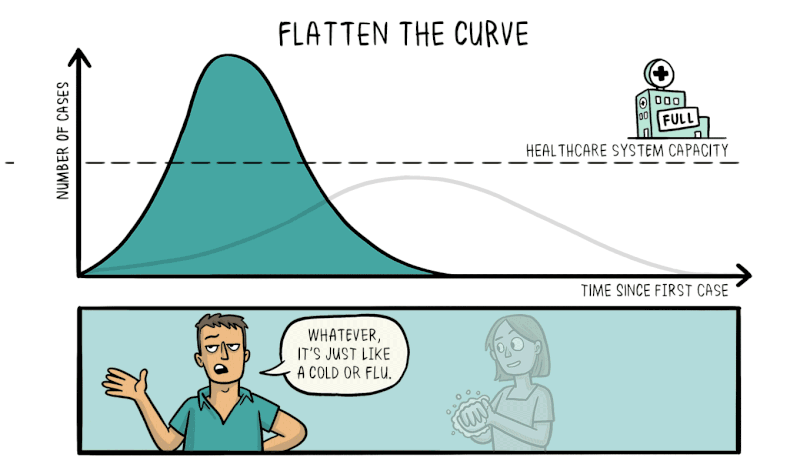Digital Verification – Lessons Learned From Social Distancing
,Rules are in place to prevent the spread of the Coronavirus. One of them is called “social distancing” which helps to stop the transmission of Covid-19. What are the rules concerning Coronavirus information online?
Rules have been introduced across the globe about how to behave in order to prevent the spread of the Coronavirus. One of these rules is called "social distancing" which helps to stop the transmission of Covid-19. It recommends we avoid crowds, take public transport at off-peak hours and keep physical distance to other people.
What are the rules concerning Coronavirus information online? Daily updates about the spread and protection of Covid-19 are crucial and easy to find–online–but not all of them are true. Sharing misinformation online is like refraining from social distancing; tempting, but it could harm people. So how can you contribute to stopping the transmission of dis- and misinformation about Covid-19?
These are the rules on how to deal with dubious information online:
1. Ask yourself: Does this information make sense?
Subsequent questions are: What sources does the information rely on? Where do the numbers come from?
2. Double check the information with reliable sources.
Like: quality journalism, fact-checkers and relevant experts. Here's how to do that:
- Google the claim using the main keywords or the headline like in this video.
- Golden rule: reverse image search a photo or video
- Use Google Dorks (a search string that uses advanced search operators) and search on a specific news sites or in a specific timeframe (see image below):
- Check Twitter lists with reliable sources on Covid-19, like these:
3. Still nothing? Wait or reach out to your doctor
Verification of videos and synthetic media
For verification of videos there are some specific rules. Here are the most important ones:
Golden rule: reverse image search a video:
The reverse image search enables a simple and quick check whether a video has been published online before, possibly in another context. This way you might also be able to retrieve the original source of the video. You can use the InVid-Plugin for selecting several thumbnails from the video and reverse search with different tools like Google and Yandex–or you take a screenshot and do the same via Google Images.
Visual content verification
Most video manipulation is still visible with your bare eye. Look at the small details visible in the video. If you think you are watching a fake you might want to check:
- strange cuts, non-fluent frames can indicate manipulation,
- does the body actually fit the face of a person and does the body language match the facial expression,
- is the person on video showing natural behaviour; e.g. blinking eyes, movement of eyes, movement of hands?
To help make it a bit easier you can check the video 'frame by frame' with VLC player and check if the colour and shadows are changing in a consistent way that makes sense to you.
With a precise eye for details you could use the verification plugin with magnifier functionality from InVid/WeVerify that enhances the quality of your zoomed area in video stills.
If there are shadows visible and you are really getting into it, you can determine when on the day the video was filmed with tools like Suncalc. Here is a detailed tutorial on using shadows.
Technical video verification
The devil is in the detail, and the manipulation technology evolves. For well done synthetic video you would need some elaborate algorithms to check manipulation. We're trying to develop those in the Digger project. What you could try is to focus on audio; check if the acoustics of a video correlate with the scene recorded–is it outside and thus with background noises, are people talking in the background, and does that match the video? And obviously if the audio does not match the lip movements with poorly implemented lip synchronization, it is more likely a fake. Still not sure, consult a forensic expert like anyone on this deepfakes forensics Twitter list.
Reliable sources
Social Media platforms like Facebook, Twitter, Youtube, Pinterest and more have taken steps against misinformation about the Coronavirus such as directing users to official sources when they search for Covid-19.
Here are some helpful trustworthy sources for everyone of us:
- World Health Organization–The WHO offers daily updates on the pandemic, guidance, and data on the spread.
- FirstDraft Resources for Reporters–Guides how to verify and a searchable archive of Coronavirus debunks.
- Sifting Through the Pandemic–Mike Caufield's simple and effective educational website teaches how to navigate online information. His approach runs counter to the news reader's natural instincts. Mike has updated this post specifically for Coronavirus.
- Fighting the Infodemic: The #CoronaVirusFacts Alliance–The #CoronaVirusFacts / #DatosCoronaVirus Alliance unites more than 100 fact-checkers around the world in publishing, sharing and translating facts surrounding the Coronavirus.
Be active and responsible in your community–and stay healthy!
This article was first published on the Digger website. Visit us there to learn more about detection of shallow and deepfakes. You can also follow us on Twitter via @digger_project.
The Digger project aims to develop:
- a video and audio verification toolkit, helping journalists and other investigators to analyse audiovisual content, in order to be able to detect video manipulations using a variety of tools and techniques.
- a community of people from different backgrounds interested in the use of video and audio forensics for the detection of deepfake content
